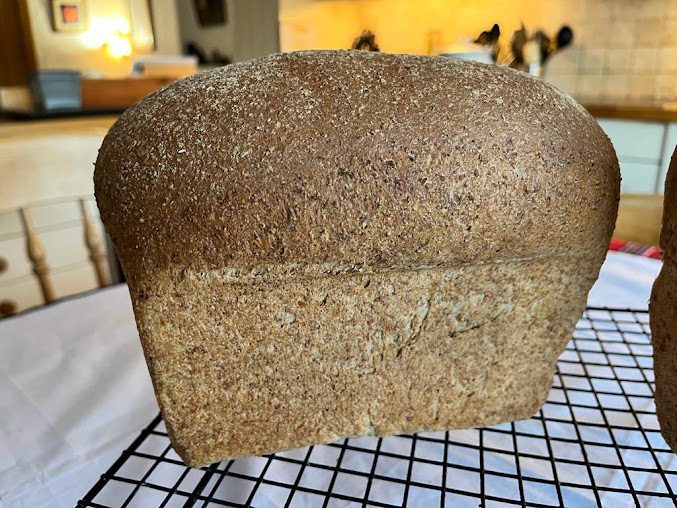Classic Wholemeal - BC20 Back to Basics
Welcome to another step-by-step recipe from BreadClub20. Why not drop by our main Facebook page by clicking here.... If you like what you see and enjoy the recipe, we hope you join us by 'Liking' and 'Subscribing'.
This is another in the series 'BC20 Back to Basics'. Today, it's a Classic Wholemeal.
Wholemeal or Wholegrain flour is made using the whole of wheat kernel. The wheat germ is separated from the white part of the grain and then returned to the white flour at the end of the grinding process.
Wholemeal is heavy flour, so we often use it with strong white flour to help lift the finished bread a little.
We're going to make two loaves.
One will be a 100% wholemeal/wholegrain flour loaf and the other will be a wholemeal/wholegrain loaf with a bit of strong white flour added to 'lift' the bake a touch.
Let's look at the ingredients:
A note on the ingredientsIn a bread machine
Add the water and salt first. Then add the remainder of the ingredients and finally, the yeast.
Use a basic wholemeal / wholegrain programme (afterwards move on to Stage 3) OR an instant start programme (e.g. pizza) and then remove the dough from the machine when it has become silky and smooth (8 minutes) and proceed to Stage 2 below.
In a stand mixer
Add the flour and dry ingredients (but not the yeast).
Slowly add the water and yeast on a low setting until all has been absorbed.
Switch to a medium setting and continue to mix until you have a soft and silky dough. Remove the dough and proceed to Stage 2 below
Hand mixing
Stage 1
Add the flour and salt into a large bowl and mix them together.
Add the oil, yeast, and water and bring the dough together.
Tip onto an un-floured board and knead for about 10 minutes until you have a soft and silky dough.
Stage 2 (join here if you've been mixing by stand, instant start bread machine programme or by hand
Stage 3 (join here if you've produced your dough by bread machine)
Prepare your baking tin(s).
Tip the dough out onto a floured board.
Knock back and flatten into a rough circle.
If you're shaping for a tin, bring in the sides so that you have a rough 'A' shape with the narrow end at the top and the bottom edge roughly the width of your tin. Bring over the top edge to a third and press down, start to roll the dough towards you until you have a compact shape that will transfer, smooth-side up into your prepared tin.
If you are shaping for a baking sheet, you can use the technique above and produce a 'batard' shape or, alternatively, bring all the edges into the middle, turn the dough over and roll the dough into a ball, or boule, draw it gently around the worktop towards you and then away from you to create some surface tension. Place it on the baking sheet.
If you're using a Pullman pan, fill the pan to halfway using the first technique but then do not replace the lid until the dough has risen to within an inch of the top of the tin. Keep an eye on the dough. If it goes too far, it doesn't matter - just bake it without the lid.
Place the dough, covered with a cloth or paper, in a warm spot until it doubles in volume. This might take 40 - 60 minutes, but it might take a little longer....or not.
WATCH THE DOUGH, NOT THE CLOCK
 |
| 100% wholemeal on the left, blended wholemeal on the right. |
Stage 4
Preheat the oven to 200⁰C.
If you wish, dust the top of the loaf with a little flour.
If you want a crisper crust - mist the inside of the oven with water just before and immediately after adding the loaf. You can also mist the surface of the loaf.
Bake the loaf for about 30 minutes until it is golden brown and hollow when tapped on the underneath.
Remove from the baking sheet, tin or Pullman tin and cool on a rack.
 |
| 100% wholemeal on the left, blended wholemeal on the right. |
Happy Baking







Comments
Post a Comment